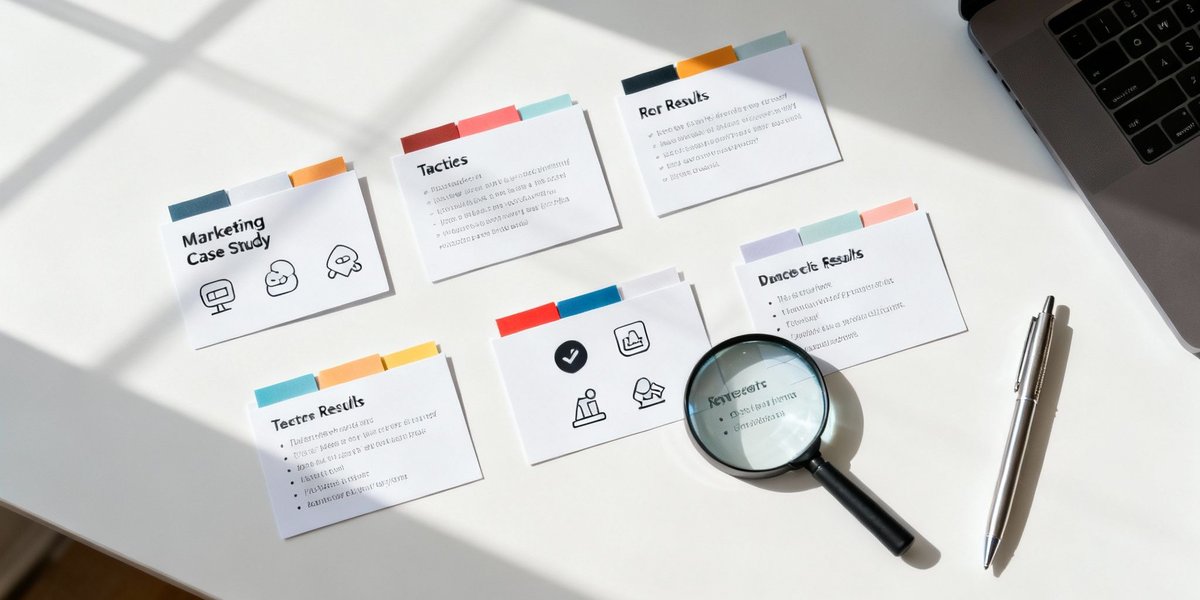
10 Clever Small Business Marketing Ideas for 2025
Feeling stuck? Discover practical, low-cost small business marketing ideas you can use today. Real examples for Australian businesses.
05 Nov 2025
Feeling stuck? Discover 10 powerful marketing strategy examples you can actually use. Get real-world breakdowns and actionable tips to grow your business now.
Blog
Let's have a real chat. Seriously. You're here because you're staring at your business, knowing it has so much potential, but the whole 'marketing' thing... it feels like a giant, tangled ball of yarn, doesn't it? You've heard all the buzzwords. SEO, PPC, content marketing, influencers. It’s overwhelming.
Sometimes it feels like you're just throwing things at the wall and hoping something sticks. I get it. I’ve been there, staring at a flatlining analytics graph at 2 am, fuelled by lukewarm coffee and a quiet sense of panic. It’s tough. You feel like you're shouting into a void. But what if we could untangle that yarn, thread by thread?
What if we looked at what’s actually working for other brands, not in some fluffy textbook theory, but in the real world? This isn't about chasing the next shiny object. It's about finding a solid, dependable engine to drive your growth.
We’re going to walk through 10 proven marketing strategy examples, from email and social media to community building and SEO. We'll break down why they worked and, more importantly, figure out how you can steal… I mean, borrow… their brilliant ideas for your own business. No jargon, just practical, real-world tactics you can actually use.
Ready? Let's dive in.
Imagine you're trying to make a new friend. You wouldn't just walk up to them and scream 'BUY MY STUFF!', right? Of course not. That's just weird. You'd chat, find common interests, maybe share a useful tip or a funny story. That’s pretty much content marketing.
It's the long game. A slow burn. It's about consistently showing up with genuinely helpful, interesting, or entertaining stuff that your ideal customer actually wants to read or watch. You're not selling; you're helping.
And over time, they start to see you as the go-to expert. The trusted friend. Then, when they are ready to buy, who do you think they'll turn to? Exactly. This is one of the most powerful marketing strategy examples because it builds an asset for your business: a loyal audience.
For small businesses, this could be a local bakery sharing recipes on a blog or a financial planner creating short videos explaining complex superannuation rules. The goal is to become an indispensable resource. To dive deeper into the practical aspects of developing compelling material, exploring dedicated resources on content creation strategies can be highly beneficial. It's all about providing value upfront, which builds trust and authority that a simple ad just can't buy.
Think about the last time you bought something based on a friend's recommendation. You didn't really question it, did you? You just trusted them. Influencer marketing works on that exact same principle, just on a much bigger scale. It’s about partnering with people who have already built that 'friend-like' trust with a specific audience.
It’s not just about paying a celebrity with millions of followers to hold up your product. That can feel a bit... off. The real magic often happens with micro-influencers, people who have smaller but super-engaged communities built around specific niches like sustainable fashion in Melbourne or Perth's foodie scene. Their followers genuinely trust their opinion.
When that influencer shares your product, it doesn't feel like a pushy ad. It feels like an authentic recommendation. This is one of the most effective marketing strategy examples because it shortcuts the trust-building process. You're borrowing credibility from someone who has already earned it. To effectively leverage influencers, it's invaluable to understand the various compensation models. Learning about how influencers make money can give you a crucial advantage in negotiations and campaign planning. The key is finding the right fit, someone whose audience is your audience, and letting their authentic voice do the talking.
Think of social media as the busiest town square in the world. Everyone you've ever wanted to talk to is hanging out there. You wouldn't just stand on a soapbox and yell about your specials, would you? Nah. You’d join conversations, share a laugh, and become part of the community. That's social media marketing.
It's about being present where your customers are. It's a two-way street, not a broadcast channel. A real conversation. You get to share your brand’s personality, listen to what people are saying, and build genuine relationships in real-time. Whether it's Wendy's famously sassy Twitter account or a local cafe showing off their latte art on Instagram, the goal is connection over conversion.
This approach is one of the most dynamic marketing strategy examples because it gives your brand a human voice. Over time, your followers become more than just numbers; they become a community of advocates. Then, when they need what you offer, your brand is the first one they think of because they already feel connected to you. It's about building a tribe, not just a customer list.
For an Aussie startup, this could be using TikTok to show behind-the-scenes chaos... which can be pretty funny. Or creating an engaging Facebook group for your most loyal customers. It’s all about showing up authentically and consistently. You’re not just selling a product; you're inviting people to be part of your story.
Imagine having a direct, personal phone line to everyone who’s interested in what you do. You wouldn't spam them with nonsense, would you? You’d send them a thoughtful message when you had something genuinely useful or exciting to share. That's email marketing in a nutshell.
It’s about building a relationship in the most personal digital space: the inbox. You're not shouting into the void of social media; you're having a one-on-one conversation. It's a powerful way to nurture leads, share updates, and guide people from being just curious to becoming loyal customers.
And the reason it remains one of the most effective marketing strategy examples is its incredible return on investment. You own the list. No algorithm can take it away from you. Think of Spotify’s curated "Discover Weekly" emails or Amazon’s spookily accurate product recommendations. They aren't just selling; they're providing a personalised service that keeps you coming back for more.
For a small business, this could be a monthly newsletter with exclusive tips or early access to a sale. It’s about making your subscribers feel like insiders. To get the nuts and bolts right, exploring dedicated resources with five email marketing tips can really help sharpen your approach. It’s your chance to consistently deliver value, building a direct connection that other channels simply can't replicate.
Imagine your business is a library book. Without a good system, it's just sitting on a random shelf, gathering dust. SEO is the librarian that organises the entire library, puts your book in the right section, and points eager readers directly to it when they ask for what you offer. It's not about tricking Google; it's about making it incredibly easy for search engines to understand what you do and why you’re the best answer to a user's question.
This strategy is about playing the long game to earn 'free' traffic from places like Google. It's a mix of art and science: finding the right keywords your customers are using, creating high-quality content that answers their questions, and making sure your website is technically sound. When done right, you show up exactly when someone needs you most.
Over time, this builds incredible authority and a steady stream of high-intent visitors. Think of how companies like Moz and Ahrefs dominate search results for anything related to SEO itself. They didn't just buy ads; they created indispensable resources that earned their top spots. This is one of the most sustainable marketing strategy examples because it builds an asset that pays dividends for years. The digital landscape is always changing, so understanding what business owners need to know about SEO in 2025 is crucial for staying ahead of the curve.
Imagine you're standing in a massive, bustling marketplace. You could spend hours shouting to get attention, or you could pay the organiser a small fee to stand right at the entrance where everyone walks past. That's PPC advertising.
It's the fast track. The express lane. Instead of waiting for customers to find you organically, you pay search engines like Google or social platforms like Facebook to show your ad directly to them. You only pay when someone is interested enough to actually click on it. It’s a direct, measurable way to get eyeballs on your offer, right now.
This is one of the most immediate marketing strategy examples because it delivers instant traffic and data. You’re not waiting months for results; you can see what’s working (or not working) within hours. It puts you in control.
For an Aussie e-commerce store, this might look like a Google Shopping ad that appears when someone searches "buy Ugg boots online". For a B2B service, it could be a targeted LinkedIn ad shown only to marketing managers in Sydney. The key is its precision. You're not just buying an ad; you're buying a specific audience's attention at the exact moment they're looking for a solution like yours. It’s powerful, direct, and incredibly effective when managed well.
Think about the last time you learned how to do something new. Did you read a dense manual, or did you just search for it on YouTube? Exactly. We’re visual creatures. We’d rather watch a two-minute video than read a 1,000-word article explaining the same thing. That’s the power of video marketing.
It’s about using video to grab attention, explain complex ideas simply, and build a human connection. From hilarious viral ads like Dollar Shave Club’s, to epic user-generated content from GoPro, video makes your brand memorable. It’s not just about selling; it’s about educating, entertaining, and engaging your audience on platforms they already love, like TikTok and YouTube.
This strategy works because it stops the scroll. A well-made video can convey emotion and personality in a way that text just can’t. For an Australian business, this could be a local tradie showing a quick DIY fix on Instagram Reels or a SaaS company creating educational webinars. You're building trust by showing your expertise in action, creating a powerful asset that engages customers and drives real results in a crowded digital landscape.
Imagine hiring a massive sales team, but you only have to pay them when they actually make a sale for you. Sounds too good to be true, right? Well, that's pretty much affiliate marketing.
It's a performance-based model. You partner with people, often called affiliates or publishers, who have their own audience. They promote your product or service, and for every customer they send your way that makes a purchase, you give them a commission. It's a true win-win.
You get access to a warm audience without the upfront cost of advertising, and your affiliates earn money by recommending products they genuinely believe in. This is a brilliant marketing strategy example for e-commerce brands, software companies, and anyone with a digital product. Just look at Amazon's Associates program, it's a huge part of their dominance. The key is to find partners whose audience genuinely aligns with your ideal customer. When you get that right, it's like pouring petrol on a fire. You're leveraging the trust that someone else has already built.
Imagine having a super-efficient assistant who never sleeps, never takes a holiday, and never forgets a follow-up. That’s marketing automation. It’s not about being robotic; it's about being incredibly smart and personal, but at scale. You set the rules, and the software does the heavy lifting.
It's the ultimate time-saver. Think about sending a personalised welcome email the second someone signs up, or a follow-up message when they click a specific link. You’re not glued to your computer doing this manually. Instead, you're building intelligent pathways that guide your customers on a journey with you.
This system nurtures leads, engages customers, and streamlines your whole process. It frees you up to focus on the big picture stuff, like strategy and creativity, instead of getting bogged down in repetitive tasks. This is one of the most impactful marketing strategy examples for businesses wanting to grow without hiring a huge team.
For small businesses, this could be a local real estate agent automatically sending property alerts based on a client's search history, or an online store sending a reminder about an abandoned cart. The goal is to deliver the right message to the right person at the perfect moment, without lifting a finger. To really nail the setup, learning about marketing automation best practices is a fantastic starting point. It’s about creating timely, relevant, and helpful interactions that feel one-on-one, even when they’re one-to-many.
Ever been part of a club where you just… belonged? Maybe it was a footy team or a local hobby group. You weren’t just a member; you were part of something. That's the feeling you're aiming for with community building and loyalty programs.

It’s about going beyond the simple transaction. You’re not just selling a product; you’re inviting customers into an exclusive circle where their loyalty is seen, celebrated, and rewarded. Think about Sephora’s VIB program or the way Harley-Davidson owners are a tribe. It’s a powerful emotional connection.
This strategy transforms one-time buyers into lifelong fans and vocal advocates for your brand. Why? Because people feel valued. They get special perks, early access, or just a space to connect with others who share their passion. This is one of those marketing strategy examples that creates a genuine competitive moat. It's not about discounts; it's about belonging.
For a small business, this could be a simple VIP email list offering early access to sales or a private Facebook group for your best customers to share tips and feedback. The goal is to make them feel like insiders, not just entries on a sales report. It fosters a sense of shared identity that is incredibly difficult for competitors to replicate.
Okay, that was a lot. We've journeyed through ten powerful marketing strategy examples, from the slow burn of SEO to the rapid-fire engagement of a viral social media campaign. Feeling a little bit of information overload? That's completely normal.
It’s easy to look at that list and think you need to do everything. You see a competitor killing it with video and another dominating with their email newsletter, and the pressure mounts. You start trying to spin ten plates at once, and pretty soon, they all come crashing down. That’s the path to burnout, not breakthrough. Trust me, I’ve been down that road.
The secret isn’t doing more. It’s about doing less, but better.
Look back over the examples we've explored. Which one genuinely sparked some excitement for you? Forget what you think you should do for a moment. Which one felt like, 'Yeah, I could actually do that for my business'?
That spark… that’s your starting point. Don't try to build a ten-pillar marketing empire overnight. Just pick one of these marketing strategy examples and commit to it. Give it a real, honest go for the next 90 days. Master it. Learn its quirks, measure its impact, and refine your approach until it becomes a reliable engine for your growth.
Marketing isn't about finding a magic bullet. It’s about the focused, consistent execution of a well-chosen strategy. It's about taking that first small, deliberate step. Then another. And another. True momentum is built not from frantic, scattered activity but from disciplined focus. You’ve now seen what’s possible and have the foundational knowledge from these real-world marketing strategy examples to make an informed choice. You've got this.
Ready to choose your first step but want an expert guide to make sure it's the right one? At Cemoh, we connect you with vetted, top-tier marketing strategists who've executed these plans countless times. Find the perfect fractional CMO or specialist to build and run your strategy, ensuring your first step is a confident leap forward.
Here are some suggested articles that are closely related to this post

Feeling stuck? Discover practical, low-cost small business marketing ideas you can use today. Real examples for Australian businesses.

Build a small business marketing strategy that works. This guide offers practical, no-nonsense tips for real results, designed for Australian business owners.

Finally, a practical marketing strategy for small business owners in Australia. No jargon, just real-world advice to help you connect with customers and grow.

What is digital marketing consulting and how does it work? We explain what a consultant does, why you need one, and how to hire the right partner in Australia.

Need a marketing consultant for small business? Discover expert tips and guidance to boost your small business marketing success today.

Explore how a fractional CMO Australia can elevate your marketing strategy, reduce costs, and drive growth for your business. Find out more now!